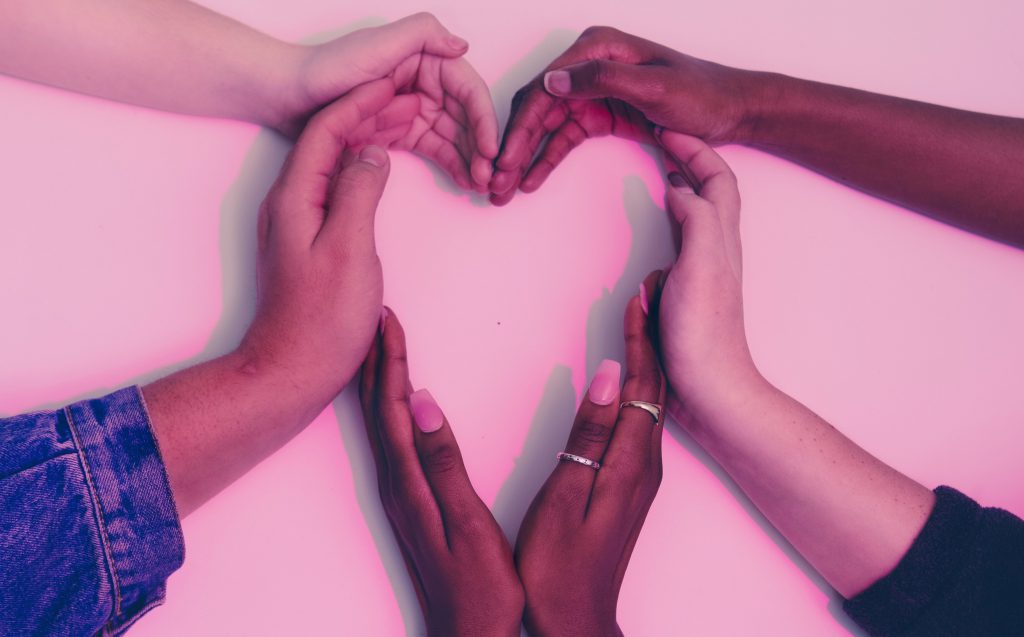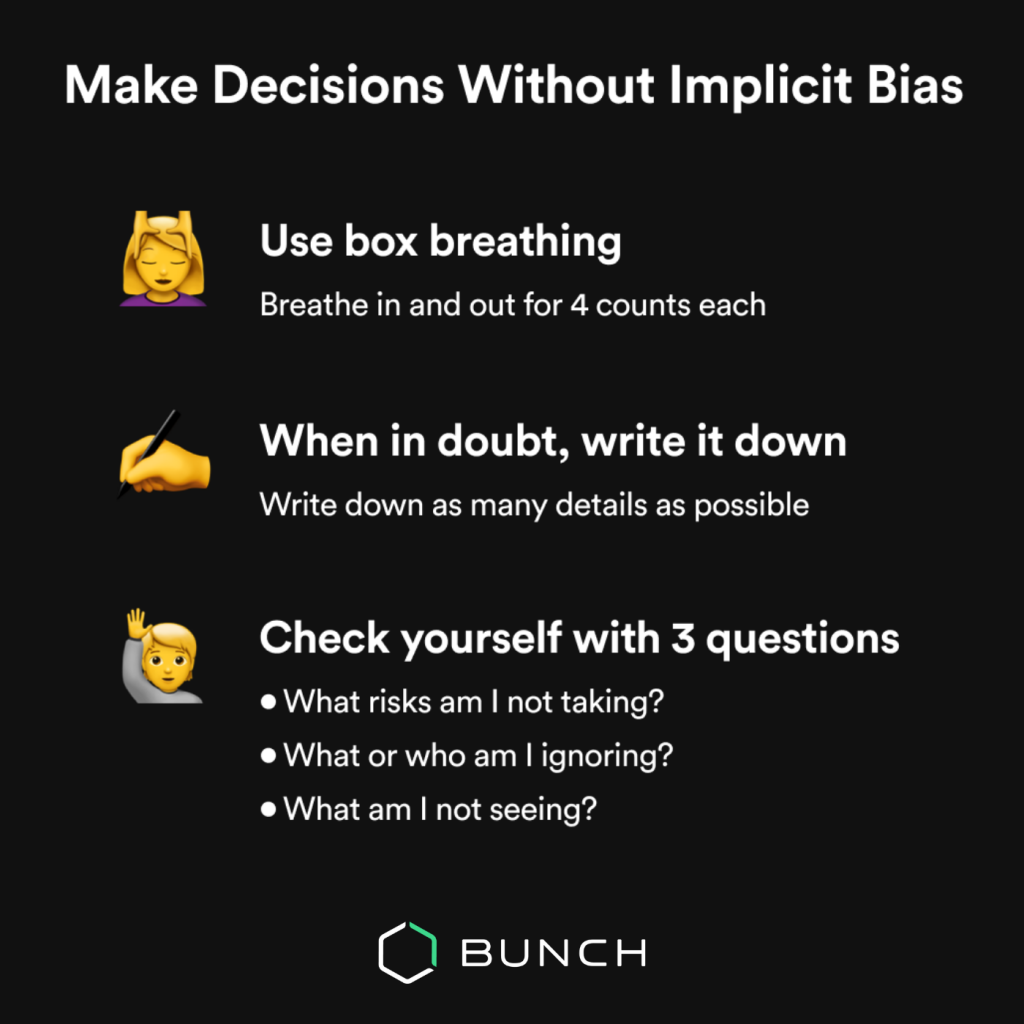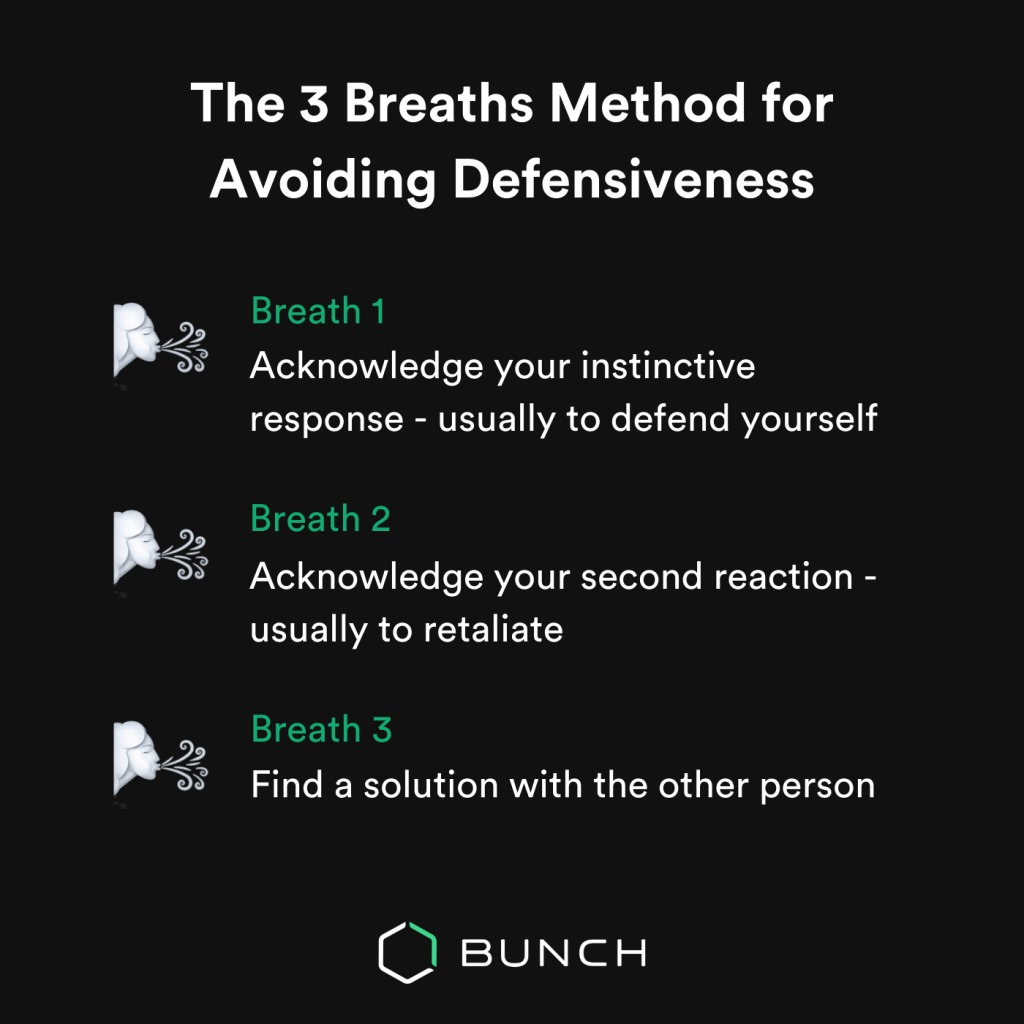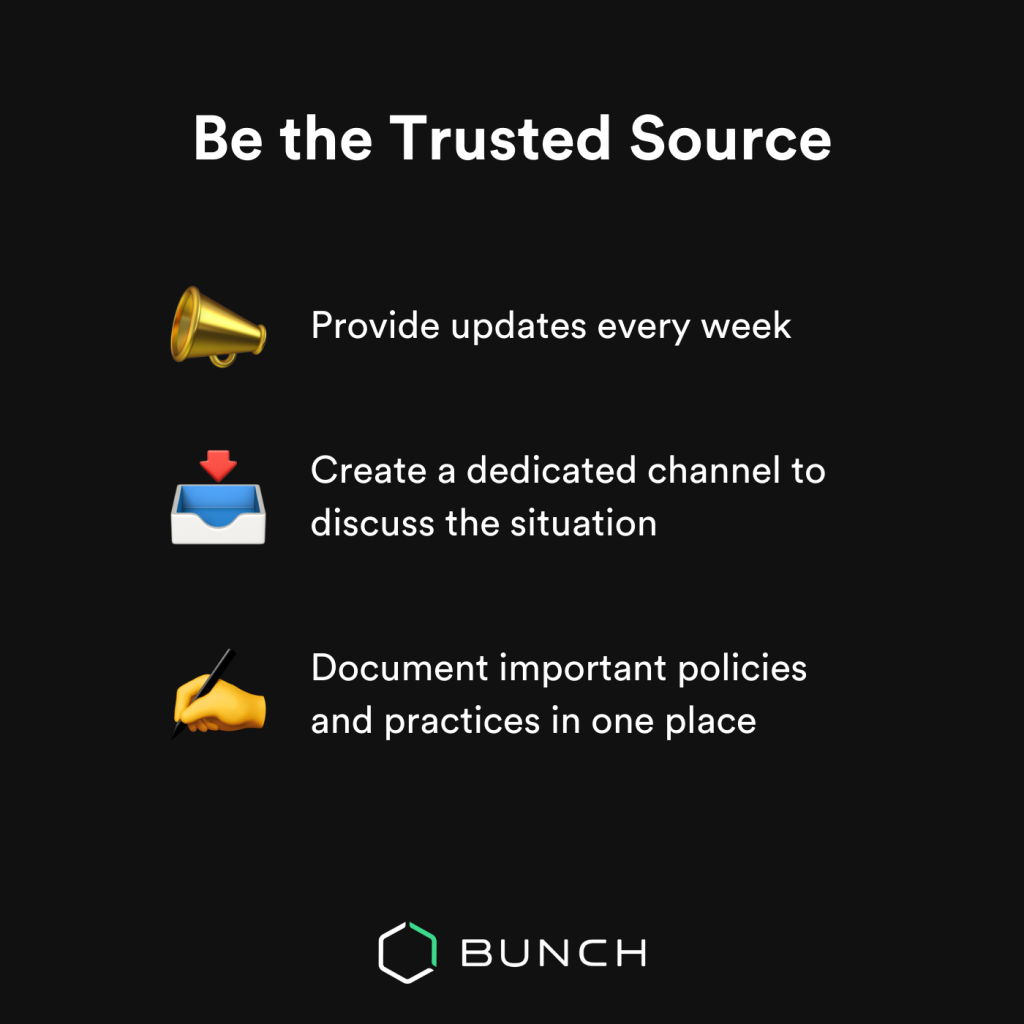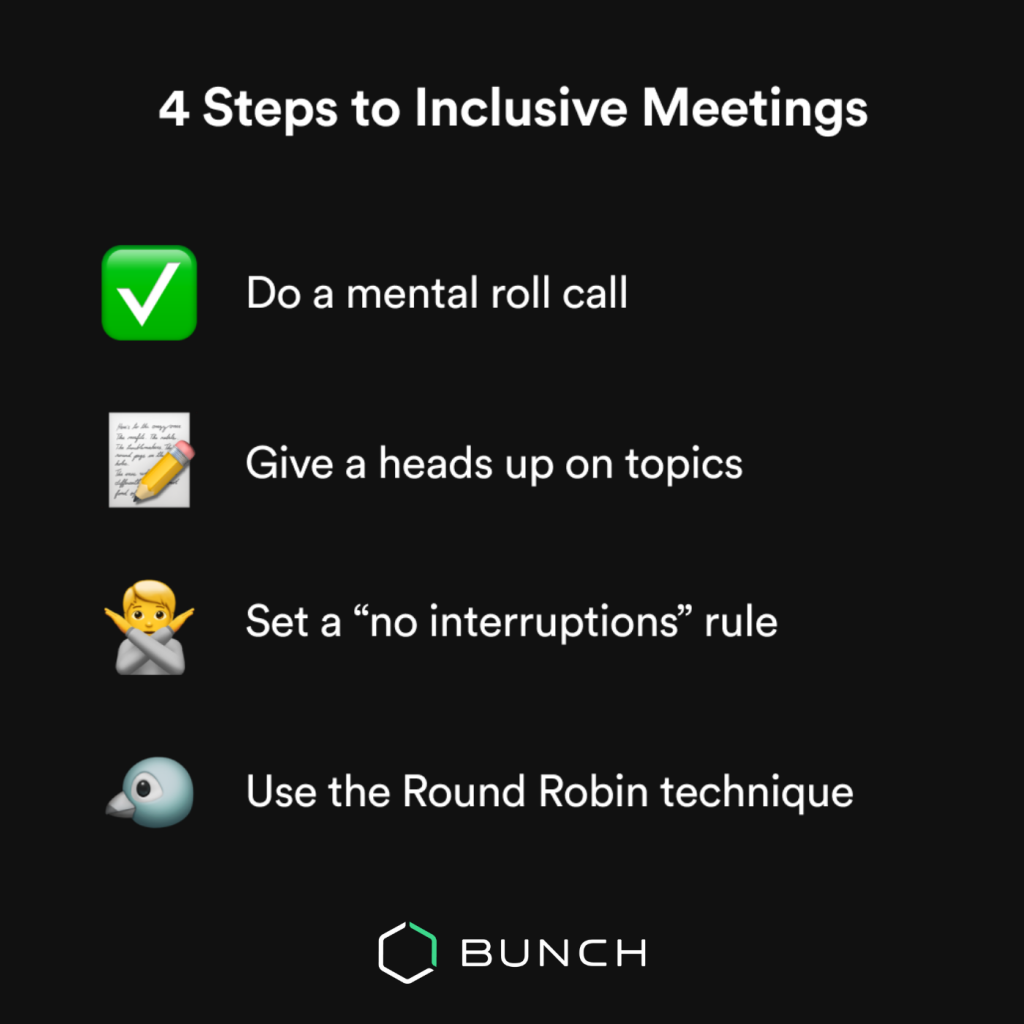A note: There are times when “people of color” is used in this guide. We try to specify as much as possible, especially in light of the particular needs to uplift and support the Black community. But the main use of “people of color” as an umbrella term to group together all non-white individuals serves to communicate that these principles also apply to a range of ethnicities and identity groups.
Despite this, support for the Black Lives Matter movement is urgent and should not be overshadowed. We must act now, amplify Black voices, donate, vote, and continue our work to dismantle systemic racism.
Taking action in your personal life
- I want to do something but I don’t know where to start.
- I don’t know enough about racism to speak up or do anything.
- What’s the difference between “racist” and “not racist”?
- How do I stand up against racist statements or acts that I see in the world?
- I don’t have time to learn about racism and lead a team/live my life.
- I know I probably have prejudices and stereotypes in my head. What do I do about it?
- If I say something accidentally and don’t intend for it to be racist, is it still racist? What do I do?
- People in my family or close circle of friends are racist. What do I do?
- The people in my life aren’t very diverse. How can I change that?
- Do I have to do this self-education forever? How do I keep from letting it die out?
Bringing that initiative to work
- What are my responsibilities in addressing this as a leader?
- I feel uncomfortable talking to my team about racism. What do I say?
- Speaking about race in the workplace is inappropriate or unprofessional.
- I want to have an impact beyond just a casual conversation with my team. How can I learn about and act on diversity and inclusion?
- How do I support my team during and after this time?
- Should I address the issue as a group or in my 1:1s?
- What if I don’t have any people of color on my team?
- How do I address this specifically with people of color on my team?
I want to do something but I don’t know where to start.
First off, you’re not alone. It’s completely normal to feel overwhelmed. Actively fighting racism is no small issue, that’s for sure. But we’re here to help answer your questions so that you can do the same for your team.
By coming to this FAQ guide, you’re taking steps toward being a better ally. Let’s keep that momentum going. Below, you’ll find a series of resources that will help you answer some of the most pressing questions or concerns you may have.
Keep in mind that it’s important to always push forward. Even if that means taking your morning coffee to educate yourself or using five extra minutes to explain to your friend why something they’ve said is racist.
We’re here with you. Let’s keep moving.
Taking action in your personal life
As a leader, there are two main spheres you’ll be able to impact with your anti-racist work. The first is in your personal life.
Much of this work has to do with addressing your racist behaviors and the racist behaviors of people around you.
I don’t know enough about racism to speak up or do anything.
Being a leader often means that people turn to us for the answers. So when we’re faced with racism – even in our personal lives – it’s hard not to feel like we should have a world of knowledge under our belts before we can act.
Fortunately, it actually doesn’t take much knowledge to know when something is wrong and express concern. You don’t have to be a politician, you don’t have to be a specialist in anti-racism work, all you have to be is a human who is willing to put in the work.
You’ll be glad to hear it’s actually not as difficult as you may think; it just requires continuous and honest effort – like anything in life that is actually fruitful.
To get started, there are a few key pieces of information that are helpful to know:
The first is understanding what a racist statement looks like.
- Follow @thegreatunlearn and have a look at case examples like the one below that breaks down racism line by line. You can also join The Great Unlearn here.
Next, you should read up about white privilege and fragility (while we all have privilege, even if we’re not white, white privilege is without a doubt the most powerful kind of privilege, so it’s important to understand it as a whole).
- Read “White Privilege: Unpacking the Invisible Knapsack” by Peggy Mcintosh
- Read White Fragility by Robin DiAngelo
To help get through that feeling of “I don’t know enough” it’s also great to dive into some easy-to-digest content that helps break down complex systems and ideas.
- You can get a really great overview of how you can help in this Guide to Allyship. This guide is helpful for any allyship – even beyond the work we need to do now for the Black community.
- Danielle from @ohhappydani also does an excellent job of visualizing some problematic statements and expressing difficult concepts through her art.
What’s the difference between “racist” and “not racist”?
“Not racist” is not an option. In fact, it doesn’t really exist in the modern world. You can either be “racist” or you can be “anti-racist.”
What is anti-racism? Glad you asked. Although you can find several definitions, the Ontario Anti-Racism Secretariat defines it as “the practice of identifying, challenging, and changing the values, structures, and behaviors that perpetuate systemic racism.”
In the simplest words possible, being an anti-racist is showing up every day and actively making efforts to fight racist institutions, organizations, and people. It’s an active, rather than passive, identity.
But this is no news to you. Being a leader means that you’re accustomed to taking action. Equipped with your self-education and your sphere of influence, you’re completely ready to become a great anti-racist.
- Watch “Why ‘I’m not racist’ is only half of the story” with Robin DiAngelo
We’ll explore next how to do just that. If you’re interested in diving deeper into anti-racism, we’d recommend reading How to Be an Anti-Racist by Ibram X. Kendi.
If you’re interested in understanding more about the history of slavery and racism (especially in the United States) take a look at the New York Time’s, The 1619 Project.
How do I stand up against racist statements or acts that I see in the world?
Now that you know a little bit more, it’s time to act! Those casually racist statements shouldn’t just slide by. We have to hold each other accountable.
We’re not saying it’s easy. In fact, it’s going to be quite challenging. But once you’re in a pattern of speaking out against racism, the discomfort will start to feel more normal, and you’ll be able to confidently respond to what you see and hear.
Some suggestions from @sineadbovell can help you to craft your own responses to racist statements, as it’s important to speak for yourself instead of only following a template.
You can also use our tip on responding to racist comments on your team (though this applies even outside of the office).
It’s likely that you’ll come up against racist statements more often than racist acts, but there are also ways you can help anti-racist movements as well as dismantle racist systems.
The first way is by using your right to vote and your ability to pester politicians who speak for you.
A great example of emails you can send to local representatives and officials can be found here for if you’re a non-US citizen. You can also find petitions, emails, and other initiatives in this Resource for Accountability and Action for Black Lives. Being a leader, you’ll know how much impact these leaders can have as well!
Another way of taking action is by donating to causes that are actively working to combat systemic racism. If you want your peers to take similar action, you can screenshot and share the proof of your donations (you don’t have to include the amount) as this makes other people more likely to donate as well.
I don’t have time to learn about racism and lead a team/live my life.
You don’t actually need a lot of time to learn about racism. In fact, we recently conducted a study that shows how the most successful leaders take little pockets of time to learn every day. If anything, leaders are better at fitting in moments to learn between tasks; it’s what we do all day every day!
Your morning coffee or your commute can be enough time to chip away at your self-education. It’s a long-game, after all.
If you want something to challenge you and keep you on track, check out Debby Irving’s 21-Day Racial Equity Habit Building Challenge. Every day, you just have to consume one piece of content (video, article, podcast, etc.) that educates on the topic and the impact of racism.
Some content that we’ve found particularly impactful despite being short are:
- A VC’s Guide to Investing in Black Founders
- A Poem for My White Friends: I Didn’t Tell You
- Important Terms for Talking About Race and Identity
- Racial Bias, Even When We Have Good Intentions
Pro Tip: You can bring this challenge to your team and set up a Slack channel space where you all share your daily dose of content and exchange ideas and reactions. This will make your collective effort as anti-racists more motivating and engaging.
I know I probably have prejudices and stereotypes in my head. What do I do about it?
Fighting racism as society begins with fighting racism internally. In fact, racism is rooted in a combination of psychological and sociological effects. These take place within every single one of us and also happen in groups, given a specific dynamic.
This means that we need to take our implicit biases head-on and be more conscious on how we show up in this world. Some of the times our implicit biases kick in are when we’re stressed, under pressure, or don’t have clarity. Sound familiar? Pretty much the average day for a leader!
You can use Harvard’s Implicit Bias Tests to help you understand what’s going on below the surface of your own mind and actions. You can dig even further by reading the Kirwan Institute’s Implicit Bias Review.
The real impact of these biases rears its ugly head usually when we’re making decisions. To try and hone your decision-making skills and avoid using bias to dictate your choices, you can try out this tip:
Next time you catch yourself thinking negatively about someone you don’t know but either doesn’t look like you or belongs to a different identity group take a moment to pause. Chances are you have prejudices you’re not conscious of and might be reacting because of these.
Remind yourself to switch gears and become curious about the person in front of you. Approach them as an individual, not as a member of a group.
It’s also important to elevate positive examples and role models from these groups. Actively fight the perspective that successful people from these groups are the “exception” and help others to prevent their own prejudiced narrative and spin.
If I say something accidentally and don’t intend for it to be racist, is it still racist? What do I do?
The quick answer to the question is: yes, it’s still racist! Racism usually has little to do with intent and a whole lot to do with impact. That’s part of what makes it so dangerous and difficult to take on.
If you said something racist accidentally, it’s likely that you’ll only realize it’s racist after someone points it out. So not only should you be aware of your statements, but you should also be cognizant of your response.
If someone flags something you’ve said as racist, try not to get defensive. You can use the 3 breaths technique to stay in control of your emotions and take the feedback on board. This will help you learn to even recognize racist statements even in yourself.
People in my family or close circle of friends are racist. What do I do?
For many, speaking to family and friends is the hardest conversation of all. It’s personal, and often messy if it doesn’t go well. Many of you might have racist people in your inner circles, or perhaps just people who are happy to remain silent (and complicit).
The first part is not to make it an event. Make it a casual conversation and be open to hearing opinions that may oppose your own. Here are some great steps that do just that:

Just like you can introduce this to your team, you can also do Debby Irving’s 21-Day Racial Equity Habit Building Challenge with your family or friends as well.
If you’re not looking to do a formal challenge, try also just forwarding resources that you find particularly striking (like this one or the other sources used here). Sometimes sharing an article or video can be the best way to start a conversation.
The people in my life aren’t very diverse. How can I change that?
It’s not uncommon to surround ourselves with people that look and act like us. And it’s usually not intentional. That’s just what we’re more consistently exposed to.
But it also means that we need to make more effort to invite and embrace diversity into our lives. If you’re not living in a major city or diverse neighborhood, it’s likely that you’ll spend most of your time with people just like you.
In a recent Forbes piece on Why Building Diverse Friendships Can Improve Your Career, Kourtney Whitehead suggests these steps to “better align what you value about diversity at work with your personal life and help new friendships grow naturally.”
- Go places and do things where you’ll meet new people – volunteer, engage in your community, and do things that will introduce you to new people from diverse backgrounds.
- Try multitasking while forming friendships – we’re busy bees, but we still need time for friendships. Try hitting the gym, going to the grocery store, or co-working together with new people you meet.
- Embrace your phone – use social media, text, and calls to stay in touch and develop deeper bonds with the people you meet.
These tips are especially useful because most of the time having more diverse groups of friends involves meeting new people and forming new friendships. This takes something that most leaders don’t have: time!
But the payoff is amazing for having such a wide range of friendships and is certainly worth the effort.
Do I have to do this self-education forever? How do I keep from letting it die out?
The short answer is: yes. You do have to do this self-education forever. But the longer you do it, the more it will just naturally become part of your day – like listening to your Bunch tip with your morning coffee.
The truth is that allies often lose steam after a certain amount of time. You’ll notice certain people return to “business as usual” and this can cause allyship to fizzle out. It’s only when tragedy strikes again in the public eye that the next wave of allyship hits.
You can tackle sustainable support for #BlackLivesMatter and the fight against racial injustice in a few ways, some of which are covered here by @allies4blm_oc.
The most effective way of sustainably supporting the black community is by flooding your spaces with diverse views, businesses, and people. Follow accounts like @rachelcargle @ohhappydani @blairimani and other organizations on Instagram. Do the same for Twitter and LinkedIn. Be purposeful in what content you consume and what sources you turn to.
In the business world, this means also introducing inclusive leadership practices and anti-racist norms into your workplace. We’ll explore a few ways to do that next.
Bringing that initiative to work
Work is definitely a place to talk about race. Not talking about it is an active contributor to upholding systemic racism.
Our anti-racist efforts at work can include not only addressing overtly racist comments and behavior, but also the deep-rooted systemic racism that exists in hiring practices and the corporate world as a whole.
The fact of the matter is that we bring our prejudice and bias with us to work. This can come out in many scenarios. Some examples are:
- When you grab your purse when a Black man walks by, or cross the street to avoid a group of Black people on your way back from lunch.
- When you don’t hire a Black candidate because you “wouldn’t get a beer with her, so she’s probably not a fit.”
- When you double-check your Black team member’s work, but no one else’s.
These things don’t make you a bad person, but when you’re bringing your implicit bias and subvert racism to work, you have to bring your anti-racist initiative to work as well.
What are my responsibilities in addressing this as a leader?
You are the catalyst for change on your team. Your impact and influence is massive, which is why you’re always looking to be a better leader for them in the first place.
Here are 3 clear reasons why you must have open-hearted, candid conversations with your team right now:
- Everything you do has 10x power. Your people are looking to you – as a person, not as a business actor – to see how you treat people, not which KPIs you report. We know it sounds harsh, but it is true. You don’t want your team to guess what you think about the topic, you want them to know what you think.
- If you’re unsure how to react, how do you think your team feels? Imagine your feelings multiplied by ten because chances are they can’t speak up and voice all the things they are feeling. So they sit there bottling it up. You have to make the first steps to help them move through these emotions as well.
- Last but not least: The work we’ve mentioned throughout this blog starts with you, and your direct surroundings. It’s your duty and your obligation to talk about race, your prejudices, and the fight for a more equitable, tolerant, and diverse society – if you want to actually be anti-racist, that is. If you don’t stand up for it, who will?
Fighting racism is everyone’s problem. But it’s especially important for you because you’re a leader. Your sphere of influence means that your actions will impact more people around you than is typical.
The beauty of this power means that you can use it for great change, especially now. You have the ability to stand up for what you believe in and show your team what a true leader does in times of crisis.
As cheesy as it sounds, you have the ability to change the world through your actions as a leader.
I feel uncomfortable talking to my team about racism. What do I say?
There’s no shame in not knowing what to say, but you have to say something. It’s also important to know that it’s never too late to address racism and your anti-racist views.
In fact, it’s perfectly human to share your vulnerability in not knowing what to do or say. It’s likely that other members of your team are feeling the same.
If you’re struggling with how to make a clear statement or take a stance, you can take a look at this example from LifeLabs Learning. This includes tactics for 1:1s, all hands, breakout sessions, and more.
If you’re feeling uncomfortable because you don’t feel you can be vulnerable with your team, or there isn’t an established trust, there are steps you can take to solve that, too.
Even beyond the needed discussion on racism, you can start encouraging vulnerability-based trust with your team. This will help establish a foundation where you can really bring any conversation to the table in the future.
Try out this tip to get started:
Speaking about race in the workplace is inappropriate or unprofessional.
Speaking about race, racism, and your anti-racist stance will help your employees feel valued. This leads to higher productivity. Speaking to your team – especially the Black people on your team – is essential to appreciating and valuing them.
A great place to start in understanding how this taboo topic is needed in the workplace more than ever is by reading this article titled “Is it Time to Talk About Race and Religion at Work?”
Not talking about race at work perpetuates systemic racism. It means that you’re closing your team off to even looking for signals of the practices in place that overtly or subvertly put Black people at a disadvantage.
“Most people discount what they can do to help systemic racism but something as simple as addressing the language in your job recs and making sure your interviewers are trained to ask and listen for objective signals can help in this area.” – Kindra Mason, Director of Community at M13
Another major reason why you need to talk to your team about race is that they may have no one else guiding them to do so. Just like you, your team may be struggling with what to do or where to go. This anxiety can impact their work; it’s important that you help ease that anxiety as their leader.
One way of doing this is to be the trusted source for your team, and lead the anti-racist movement internally:
I want to have an impact beyond just a casual conversation with my team. How can I learn about and act on diversity and inclusion?
Not only can you learn about inclusive leadership, but you can start practicing it right now!
You can use this link to find 50+ ideas on how to cultivate diversity and inclusion in your workplace. This has heaps of ideas on how even the smallest things can help. You can even do this quick tip on making your meetings more inclusive right now:
Additionally, take a look at this Inclusion Audit Tool from LifeLabs Learning to see what you’re doing already, and where your team can improve.
Another great read is “So You Desperately Need to Hire For Diversity?” which helps break down reactions if you look around and realize that you’re working in a Predominantly White Space (PWS).
Here are some other ways that you can take action and aid diversity, equity, and inclusion efforts:
- Make conscious decisions: choose to live in diverse neighborhoods, support and shop at Black-owned businesses, and amplify Black voices.
- Support minority founders – we’re big entrepreneurship lovers, here!
- Mentor and volunteer to be exposed to people from different backgrounds and walks of life. If you are into tech, you could support Black girls/women who code.
Finally, a great book to read is Let Them See You: The Guide For Leveraging Your Diversity at Work by Porter Braswell, the CEO of Jopwell. The primary audience of the book is people of color, but the perspective is incredibly important for any leader to be exposed to.
How do I support my team during and after this time?
Aside from the other ways we’ve listed that you can speak to and support your team, you can also help your team through some of these actions:
- Remind your team of mental health/counseling services
- Show the anti-racist work you are doing to acknowledge your role & make a difference
- Bring in a professional therapist for team conversations
- Use racial equity impact assessments to understand how decisions will impact people of color.
- Model the behavior you want to see by telling them what you are doing to help, knowing that you are only one person, and it will never be enough.
- Example: “I will be at the next demonstration, am donating to X organization, and will be posting publicly to my network every week.”
- Remove the barriers stopping your team from acting. Give team members a feeling of control by curating the most impactful channels and resources for them, whether donations, petitions, etc.
Should I address the issue as a group or in my 1:1s?
The answer to this question completely depends on the dynamic of your team. Do you feel comfortable being vulnerable with your team already? Do they open up to you regularly?
Make sure that you’re calibrating to your team’s needs. These issues aren’t appropriate for the last 15 minutes of your weekly all hands. Rather, you should try to put aside designated time, preferably at the end of the workday, to speak as a group.
You should be making some sort of statement and taking a firm anti-racist stance to your entire team even if you don’t think 1:1s are necessary. But you may have members of your team that find they need more support from you. Leave the door open to them.
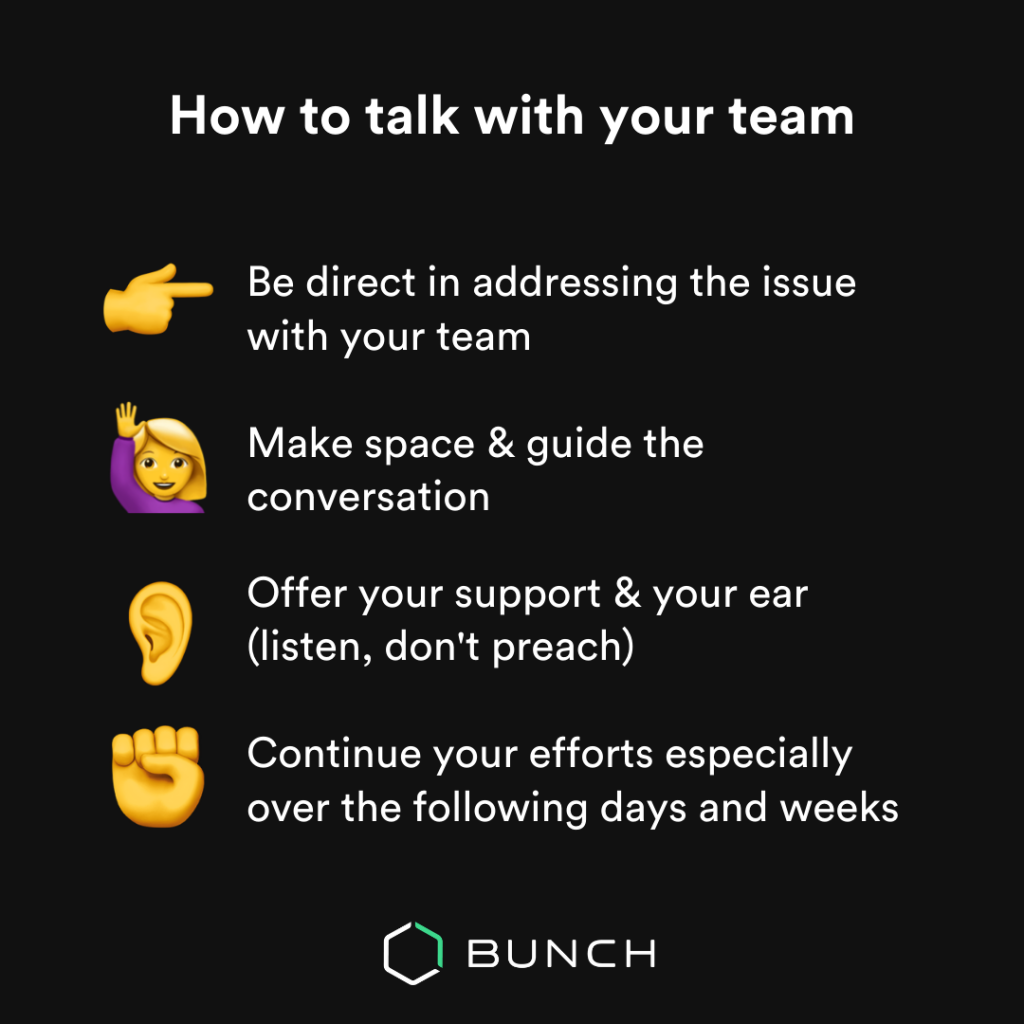
It’s a good idea to open the floor during your 1:1s to check on your team. Some great suggestions for your 1:1 dialogue come from LifeLabs Learning:
- What would be the most helpful use of this time? We can talk about what you’re experiencing, focus on work, or just take a break.
- Would you like to talk about what’s going on in the world? What else is on your mind?
Anything else?
- Where are you getting support?
- What’s one thing I can do to make work easier for you right now?
- Would it feel good to brainstorm actions you’d like to see us take as a team or as a company?
- We can talk about this anytime.
- I really appreciate you trusting me with this.
You can also dig into LifeLabs Learning’s guide to see how they handled all hands and breakout sessions internally.
What if I don’t have any people of color on my team?
Even if your team is 100% white, you should still be addressing the issue (hopefully we’ve made this bit clear by now). It’s even more important in many cases because it might be the case that the people on your team have little to no exposure to anti-racist dialogue.
While you should always keep in mind that no one person is a representative of the entire identity group they fall in, you can also read up on diverse life perspectives for better exposure.
A great piece called “This Is What Black Burnout Feels Like” by Tiana Clark can give you some great insight that might make you a better leader for when you do have a BIPoC on your team in the future.
If you want a deeper dive into these perspectives and the Black Lives Matter movement in particular, read When They Call You a Terrorist by Patrisse Khan-Cullors and Asha Bandele or So You Want to Talk About Race by Ijeoma Oluo.
You should also work with your teams to ensure that diversity and inclusion is a priority moving forward. A lack of people of color on your team means that there are entire perspectives missing from your team which directly impacts your business.
How do I address this specifically with people of color on my team?
Reaching out to the people of color – or specifically the Black people – on your team to have an open discussion can be daunting, especially if you’re not a person of color, yourself. But it is important that you let these team members know you’re in their corner.
Before you dive into a conversation, try checking out these pieces to give you some perspective.
- How to Check-In On Your Black Friends and Coworkers
- Your Black Colleagues May Look Like They’re Okay — Chances Are They’re Not
When you are educated and ready to do so, you can start with these do’s and don’ts:
- DO SAY: “No need to respond — just want to tell you I love you, I value you, and I’m here for you.” (@Mariah_Driver)
- DON’T SAY: “This is so tragic. How can I support you?” or “I can’t believe this!” (Turns conversation to you/ it is very real for them) (@Kelendria Keys Slider)
- DO SAY: “I’m holding space if you need someone to listen” and “Is there anything I can do for you?” (@Kelendria Keys Slider)
- “Please let me know if there’s anything I can do, even if you just want to talk about what’s happening. I understand if you don’t, and I won’t be offended. But I just want you to know that the door is open and that I care.” (HBR)
- DON’T SAY: “You’re so strong” (this is patronizing) or “Are you okay?” (they’re probably not)
Acknowledge that you can’t fully understand the extent of what POC experience, but you’re willing to listen and learn.
After you reach out, the job isn’t done. You need to keep in mind a few key reactions:
Understand silence
“Checking in is about the other person, not about you,” Dr. Gómez says. “Reaching out is about opening a door of communication. It is up to the other person if, when, and how they’d like to go through that door with you.” (Jennifer Gomez, Ph.D.)
And remember that the battle doesn’t end with this conversation:
“Examine how you are / are not promoting racial justice in your workplace, family, community, country, and across borders” (Dr. Gómez).

Things you should avoid doing:
- Staying silent
- Being “colorblind” or pretending nothing happened
- Pretending you know what it’s like to be Black or a POC if you aren’t
- Relying on Black or Brown leaders to educate you
- Asking Black or Brown leaders to comfort others
- Assuming how they’re feeling
The bottom line is that this is a collective effort, but we all need to do our part. As a leader, you have an incredible gift of influence and impact. Your team and the world around you will benefit from your action and self-education.
“We must be the change we wish to see in the world.” – Gandhi
If you’re still not sure what to do or where to go next, this image from Melida Briana Epler is a great overview:
If you want to find some more resources or peruse the great lists out there on your own, you can take a look at some of them here:
LifeLabs Learning: Diversity, Equity, & Inclusion Playbook (WIP)
Anti-Racism Resources for White People
Scaffolded Anti-Racist Resources
Act Now, Support People of Color
Resources for Accountability and Actions for Black Lives
Airtable’s Anti-Racist Resources

